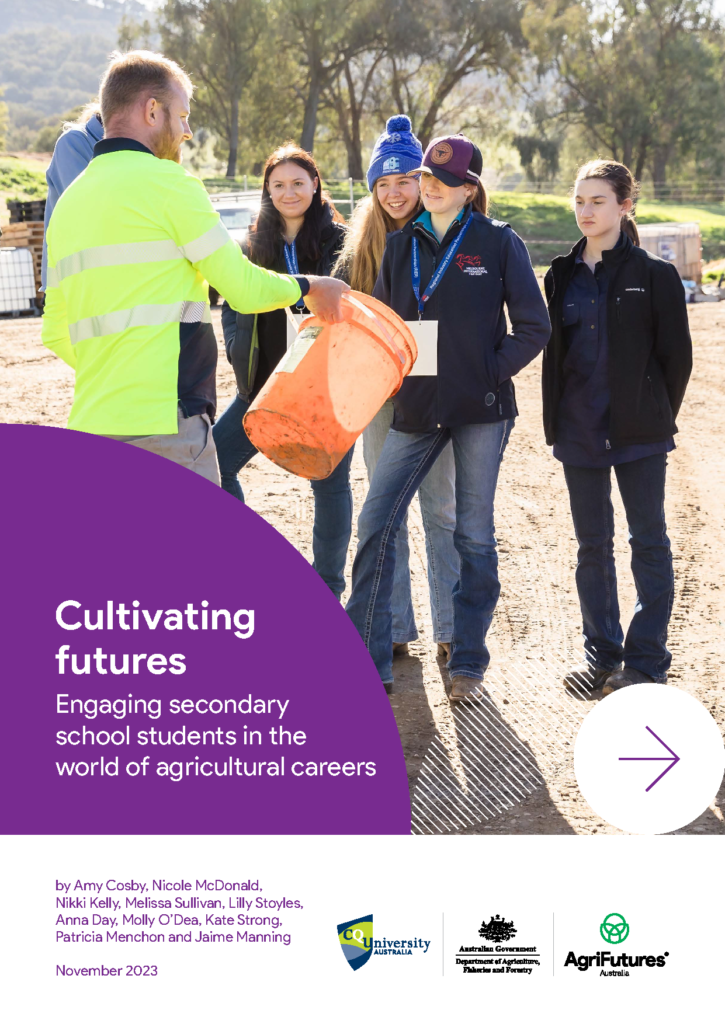National Schools Food and Fibre Education Strategy
The National Schools Food and Fibre Education Strategy aims to transform how Australian students learn about the nation’s $80 billion food and fibre sector.
 WORKFORCE AND LEADERSHIP
WORKFORCE AND LEADERSHIP 
99 pages
Published: 26 Mar 2024
Author(s): Amy Cosby, Nicole McDonald, Nikki Kelly, Melissa Sullivan, Lilly Stoyles, Anna Day, Molly O’Dea, Kate Strong, Patricia Menchon, Jaime Manning
ISBN: 978-1-76053-464-6
Download report PDF
DownloadPurchase a hard copy - AUD $60
Without an engaged, motivated and highly skilled future workforce, the agriculture industry will struggle to reach the National Farmers’ Federation’s aspirational target of being a $100 billion industry by 2030. Achieving this goal is hampered by poor community perceptions and misinformation about agricultural careers, including that they are all laborious, geographically restricted and poorly paid.
As technology is integrated along the food and fibre supply chain, and agricultural businesses become more complex, the importance of attracting and retaining a highly skilled pipeline of talent increases. The future workforce is dependent on the next generation having a favourable perception of the sector as an employer of choice, with opportunities suited to their personal strengths, values and interests. Critical to encouraging students to embark on a career in agriculture are teachers and career advisors.
This research developed, delivered and evaluated a suite of five agricultural career education resources recommended in Phase 1 of this project. These resources were designed to be used to upskill and engage educators who provide career advice to students, to build better knowledge and connections with the world of agricultural work. The resources included:
(1) Curriculum-aligned lessons for five subject areas – agriculture, science, food technology, business and digital technology.
(2) Twenty industry ambassador career videos (two to three minutes) that highlighted key aspects of careers that students seek out when considering career pathways, including salary, location, education and training, and opportunities for progression.
(3) An incursion and excursion program across every state and territory, which involved 19 schools, 514 students and 35 teachers.
(4) A work placement guide for industry, schools and students to assist with organising valuable work placements for students.
(5) Three one-day professional development workshops, one two-day workshop and two online webinars for educators, which delivered training to 247 educators in the use of the classroom and work placement resources.
Each resource trialled within the national outreach program was designed to improve Year 9-12 students’ and educators’ knowledge and perceptions of the numerous agricultural career opportunities across Australia. The resources were tested directly by educators in their own classrooms, as well as via the outreach program facilitated by the project team in each Australian state and territory, to ensure national impact.
Quantitative data collected via surveys of program participants was analysed using descriptive statistics of participants’ perceptions of agricultural careers, the delivery of agricultural career advice and education, and the impact of professional development events. Additionally, qualitative data was collected via surveys and during consultations to determine the supports and barriers of schools and industry in encouraging students to undertake an agricultural work placement, and understand student motivations to increase awareness and aspiration for a career in agriculture.
The report concludes with key insights and outcomes for each project activity, and eight recommendations, including possible next steps.